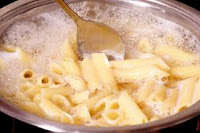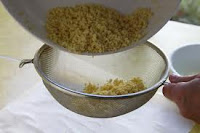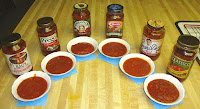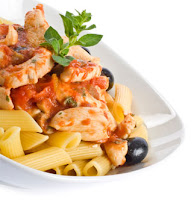It is very simple to make your own fresh italian pasta at home.The secret of cooking pasta is to use plenty of water. Cooked pasta should be 'al dente' or "firm to the bite". Undercooked pasta is undesirable and has a taste of raw flour, whereas overcooked pasta will be soft and sticky. Generally speaking, fresh pasta will take about 2 to 5 minutes to cook. Fresh pasta does not increase much in volume whilst cooking as it does not absorb much water. Just follow these basic steps and discover the delicious taste and satisfaction of eating your very own pasta.
Time Required: 20 minutes
Fill a large vessel of water so the pasta completely deep into the water. This will ensure that the water doesn't spill when it's boiling. Don’t under-fill the pot; this will make the noodles sticky. There should be a generous water-to-pasta ratio.Turn the knob on the boiler to high.Wait for the water to boil.
2.Add Salt:
Add salt if desired.But if you add Salt, it makes pasta taste better. For a large vessel of water, 1 or 2 tablespoons of salt should be sufficient.
3.Add Pasta To Boil Water:
Add pasta to the water and stir the noodles with a long serving spoon. Take care that they do not stick to the bottom, especially when you first add them.
8.Add Olive Oil and Toss:
Add a tablespoon of olive oil and toss (optional). While this will keep the noodles from sticking, it can also create a barrier between the noodle and the sauce you add, making the results less flavorful.
9.Raise the Taste:
Raise the taste of pasta by adding any of one or the combination of these sauces-White and Red Pasta Sauce,Beef Pasta Sauce,Oregano and Thyme Pasta Sauce,Mozzarella Sauce,Pasta Pasqualina Sauce,Red-Wine Sauce,Mushroom Pasta Sauce,Eggplant Pasta Sauce,Orange and Pumpkin Pasta Sauce,Red Pasta Sauce,Pasta Sauce from Fresh Tomatoes,chillie sauce (chutney) or any other your favourite sauce.
10.Ready to Eat:
Now your homemade pasta is ready to taste.Eat it and enjoy Your pasta.You can also raise the taste of pasta by adding basil leaves, grated parmesan cheese, fresh parsley or other garnishes as desired.You can also served it to your family.
How to Make the Pasta Sauce:
For making your own pasta sauce(chutney) you just need to follow these steps-
1.Put a big saucepan on medium heat.
2.Test the heat by placing your hand several inches above the pan
3.Cover the bottom of the pan in a thin layer of olive oil.
4.Sprinkle dried herbs in the oil.
5.Add half a diced yellow onion and stir.
6.After 1-2 minutes, add several cloves of diced garlic.
7.When onions are translucent, pour 1 large can of crushed tomato or 2 regular cans into a tall saucepan.
8.Add salt, sugar, black pepper, Italian seasoning, and oregano to for a better taste.
9.Allow the tomatoes to get hot, then let the sauce simmer for approximately 15 minutes.
Note:
 |
| How To Make Italian Pasta at Home |
Time Required: 20 minutes
Tips For Making Good Italian Pasta at Home:
1.Boil Water:
1.Boil Water:
Fill a large vessel of water so the pasta completely deep into the water. This will ensure that the water doesn't spill when it's boiling. Don’t under-fill the pot; this will make the noodles sticky. There should be a generous water-to-pasta ratio.Turn the knob on the boiler to high.Wait for the water to boil.
2.Add Salt:
Add salt if desired.But if you add Salt, it makes pasta taste better. For a large vessel of water, 1 or 2 tablespoons of salt should be sufficient.
3.Add Pasta To Boil Water:
Add pasta to the water and stir the noodles with a long serving spoon. Take care that they do not stick to the bottom, especially when you first add them.
Since the noodles grow in the water, it can be hard to estimate just how much pasta you need. Read the package for serving suggestions. If there are not any, read the Nutrition Facts for the number of servings per container and split up the dry noodles accordingly. If you are cooking for two, a full package of pasta can usually make a full meal with leftovers.
4.Turn Down The Boiler:
Turn down the boiler slightly, continue to boil the pasta, and stir every so often to prevent sticking. Do not cover the pot; traditional Italian pasta is cooked without a lid. When it's been boiling for about 8-10 minutes, take a piece of the pasta out and allow it to cool.
5.Undercook the Pasta:
Alternatively, undercook the pasta by 2-3 minutes, then turn off the boiler, set the vessel on another (cool) burner, and cover for 10-15 minutes. This will slow-cook the centers of the pasta, making them firm instead of sultry(humid) or sticky.
 |
| How To Make Italian Pasta at Home |
4.Turn Down The Boiler:
Turn down the boiler slightly, continue to boil the pasta, and stir every so often to prevent sticking. Do not cover the pot; traditional Italian pasta is cooked without a lid. When it's been boiling for about 8-10 minutes, take a piece of the pasta out and allow it to cool.
5.Undercook the Pasta:
Alternatively, undercook the pasta by 2-3 minutes, then turn off the boiler, set the vessel on another (cool) burner, and cover for 10-15 minutes. This will slow-cook the centers of the pasta, making them firm instead of sultry(humid) or sticky.
6.Taste the Pasta:
Taste the pasta.If it's too hard to bite or if you see white in the center, it needs to cook a little longer. When it's cooked all the way through but still firm, it's ready.
7.Empty the Excess Water From the Filter(Strainer):
Turn off the boiler and empty the entire vessel of pasta into a filter(strainer).Whip(shake) out the excess water and then pour the pasta back into the pot. Be sure not to put the pot back onto the hot part of the stove, which can burn the bare pasta.
Taste the pasta.If it's too hard to bite or if you see white in the center, it needs to cook a little longer. When it's cooked all the way through but still firm, it's ready.
7.Empty the Excess Water From the Filter(Strainer):
Turn off the boiler and empty the entire vessel of pasta into a filter(strainer).Whip(shake) out the excess water and then pour the pasta back into the pot. Be sure not to put the pot back onto the hot part of the stove, which can burn the bare pasta.
 |
| How To Make Italian Pasta at Home |
8.Add Olive Oil and Toss:
Add a tablespoon of olive oil and toss (optional). While this will keep the noodles from sticking, it can also create a barrier between the noodle and the sauce you add, making the results less flavorful.
 |
| How To Make Italian Pasta at Home |
9.Raise the Taste:
Raise the taste of pasta by adding any of one or the combination of these sauces-White and Red Pasta Sauce,Beef Pasta Sauce,Oregano and Thyme Pasta Sauce,Mozzarella Sauce,Pasta Pasqualina Sauce,Red-Wine Sauce,Mushroom Pasta Sauce,Eggplant Pasta Sauce,Orange and Pumpkin Pasta Sauce,Red Pasta Sauce,Pasta Sauce from Fresh Tomatoes,chillie sauce (chutney) or any other your favourite sauce.
 |
| How To Make Italian Pasta at Home |
10.Ready to Eat:
Now your homemade pasta is ready to taste.Eat it and enjoy Your pasta.You can also raise the taste of pasta by adding basil leaves, grated parmesan cheese, fresh parsley or other garnishes as desired.You can also served it to your family.
 |
| How To Make Italian Pasta at Home |
For making your own pasta sauce(chutney) you just need to follow these steps-
1.Put a big saucepan on medium heat.
2.Test the heat by placing your hand several inches above the pan
3.Cover the bottom of the pan in a thin layer of olive oil.
4.Sprinkle dried herbs in the oil.
5.Add half a diced yellow onion and stir.
6.After 1-2 minutes, add several cloves of diced garlic.
7.When onions are translucent, pour 1 large can of crushed tomato or 2 regular cans into a tall saucepan.
8.Add salt, sugar, black pepper, Italian seasoning, and oregano to for a better taste.
9.Allow the tomatoes to get hot, then let the sauce simmer for approximately 15 minutes.
Note:
- By covering the vessel when you bring water to a boil, you are lowering the air pressure directly over the water, making it easier to boil.
- Never mix pasta types in one vessel. They all have different cooking times.
- Watch the cooking process carefully. Pasta can overcook very quickly.
- If the pasta is to be used in a casserole, undercook it slightly. It will finish cooking to perfection while in the oven or skillet.
Related Search:
how to cook pasta how to cook pasta correctly
how to make tasty pasta at home pasta recipes
how to make homemade pasta by hand








